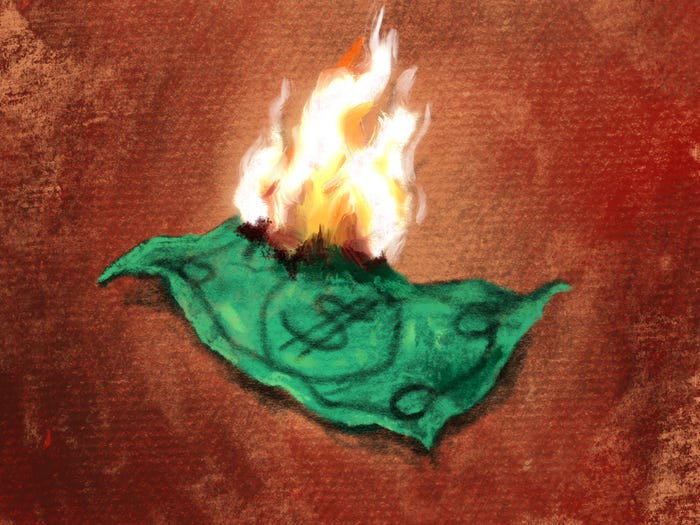All smoke and no FIRE: Early retirees open up about the struggles of ditching their paychecks in exchange for freedom and the new ways they’re generating extra income
10 min readAll smoke and no FIRE: Early retirees open up about the struggles of ditching their paychecks in exchange for freedom and the new ways they’re generating extra income

- The Financial Independence, Retire Early movement has grown in popularity since it surfaced in 1992.
- Five early retirees described challenges with managing their money and finding a sense of purpose.
- Several of them started businesses or returned to working regular jobs for steady income.
Rachel Covert earned $180,000 annually as a vice president at the fashion designer Isaac Mizrahi Live.
But her plump salary came with long hours and, eventually, burnout.
“Ultimately, the most important thing was being able to say, ‘I want to go to yoga at 10:00 a.m. on Wednesday,'” Covert told Insider.
At just 36 years old, she quit her job in exchange for personal freedom. Thankfully, she had saved up enough money in a retirement portfolio and brokerage account to make it happen. She now has almost $500,000 in both accounts, according to financial statements viewed by Insider.
But on the other end of her freedom was the fear of running out of money. She suddenly realized that the money she had saved, which once seemed substantial, was finite. She became very conscious about her budget. And although she was spending less money than when she was working, every bit felt like a lot.
By now, the realities of joining the Financial Independence, Retire Early movement had dawned on her. The FIRE movement teases an array of benefits, from being able to work out during working hours to traveling the world, spending more time with family, pursuing hobbies, launching business dreams, and exiting the 9-to-5 grind for good.
And while many people have checked these boxes, Covert and four other early retirees Insider spoke to described the challenges of having to manage a finite cash pile and survive on it for the rest of their lives. They also bemoaned losing the sense of purpose that a steady career brings and the peace of mind that comes with two guaranteed paychecks every month.
Early-retirement aspirations
The FIRE movement’s origins can be traced to the 1992 book “Your Money or Your Life,” coauthored by a duo who had themselves achieved financial independence before their forties, and which is considered a bible for how to do the same.
About 25% of Americans say they plan to leave the workforce before the age of 50, according to a recent survey of more than 2,000 respondents conducted by The Harris Poll on behalf of NerdWallet. That’s at least 12 years before they’re eligible to receive Social Security benefits and nine years before they can withdraw from their 401(k) without incurring penalties.
Still, the allure of ditching the 9-to-5 grind before the traditional retirement age of 65 has grown. One financial independence subreddit has amassed 2.1 million followers. Members pose questions from how to save and invest to how to raise a family while on the path to early retirement.
The movement even has offshoots, with some focusing on extreme frugality and others on building a large retirement fund or keeping a part-time job. For example, Lean FIRE represents those on the extreme side of the movement who live on less than $40,000 a year. Those who like to spend more — above six figures — are part of Fat FIRE. There is Barista FIRE, representing semi-retirees who maintain income-generating hustles because they haven’t saved enough to live entirely off a retirement fund.
Early retirement doesn’t mean never working again
But the FIRE movement can be more smoke than fire. Covert, who says she is practicing Barista FIRE, had to make significant lifestyle adjustments for her new reality like other early retirees. She left New York City and became a digital nomad in other countries with lower costs of living including Mexico and Portugal, eventually shacking up with her partner who owns a home in the UK.
Also significant for Covert was the reality that early retirement did not mean never working again. She has since added an income stream by working online as a money coach, allowing her to continue allocating to her retirement account.
Gwendolyn Merz also decided to reenter the workforce even after thinking she had forsaken it to become her own boss.
She graduated debt-free from college in 2013 and started her career in IT, working for a Fortune 100 company.
“It was not a great environment to be in,” Merz said. “It was toxic and I didn’t like working there, but I didn’t have any other context and I thought, ‘Oh, this is just how all work is.'”
She decided to take matters into her own hands and save as much of her income as possible with the goal of retiring early. After finding the FIRE movement in college, she spent her 20s laying the groundwork. She increased her savings rate and her income, having built a couple of extra revenue streams between her blog, podcast, freelance writing, and a rental property.
Five years and $200,000 in savings later, she decided to quit. Her plan wasn’t to stop working completely. She’d continue working, but for herself, and draw down from her savings when necessary.
Merz ran into several problems.
For starters, she couldn’t access a lot of her savings, she said.
“I had confirmed with my employer ahead of time that I would be able to cash out my pension and use that money and then they informed me that whoever had told me that twice was wrong and that I couldn’t cash it out. That was $7,000 that I was counting on.”
She was also hit with a $10,000 home-repair expense shortly after quitting.
“I didn’t have as big a runway as I thought I did,” she said.
What’s more, she wasn’t bringing in the income she anticipated. Her rental property started costing her money instead of generating positive cash flow.
“After about six months, I was like, ‘alright, this isn’t working. I need to go back to the drawing board.’ And that’s when I started interviewing to go back to a W-2 job.”
Nine months after quitting, Merz was back in IT, working for a different company.
The imperfect 4% rule
The big question when it comes to early retirement is: How much money do I need?
Related story
“You want to be really mindful of your number,” said Marguerita Cheng, a certified financial planner. “Your number is your ‘burn rate’ – how much you need to sustain.”
To figure out your number, you need to first understand what your expenses will look like. Think about what’s important to you and what you want your lifestyle in early retirement to look like, Cheng said.
“I think it’s really important for people to know that they can define retirement for themselves. What do they want to do? Where do they see themselves?”
Once you have an idea of what your annual spend will look like, you can work backwards using the 4% rule, which essentially says that you can safely withdraw 4% of your retirement assets each year.
It’s not a perfect rule, Cheng emphasized, but it’s a good starting point and can help you figure out how much you must save to achieve your early-retirement goal.
One curveball early retirees have faced in recent years has been a spike in inflation — an unpredictable factor that the rule doesn’t account for. Last year, inflation reached 40-year highs, peaking at 9%. And while it has since cooled, things are still expensive.
Meanwhile, salaries in many industries have gone up significantly in the past decade, which has been helpful. But it’s a perk that early retirees don’t have access to. In the 10 years since August 2013, average hourly earnings have risen by 41%, according to the Bureau of Labor Statistics.
Michael Quan, who retired at 36, says since he can’t predict how long he will live, he has avoided following the 4% rule by not withdrawing from his investment portfolio.
In 2013, he left his career as an IT consultant after amassing a net worth of $1.28 million and a cash cushion of $110,000 from selling his firm. He then took that equity and purchased stocks and real estate. Today, much of his monthly cash flow comes from both long- and short-term real-estate rentals. He also lives in a household with a spouse who has an income from her teaching career. This has allowed his portfolio to continue to grow, unhindered.
“Inflation is always something that swirls around and pops in my head,” Quan said. “I’m always looking at the cash flow because the cost of eating out and whatnot has gone up significantly, especially in the past couple of years. That’s a real factor that people want to consider.”
Non-financial FIRE struggles
Even with all the right money boxes checked, some early retirees face non-financial challenges, including a sense of purposelessness.
“The biggest challenge for these individuals is to decide, out of so many possibilities, which identities and purposes to pursue,” said Winnie Jiang, an assistant professor at INSEAD business school, in an article that describes her ongoing research on early retirees.
Quan faced this challenge after trading a career as an IT consultant for the freedom to spend time with his newborn daughter.
He has discovered that retiring early doesn’t guarantee happiness. While he loves being a full-time father and doesn’t regret retiring early, he misses the impact he had when he was part of the workforce. Searching for a new sense of purpose led him to start an online coaching business, teaching others how to meet their financial goals. One message he shares with his community is that early retirement may not be the ultimate finish line for everyone.
“I thought it was a destination, that I had to get to that place where I could pull the trigger and the cash flow could cover the expenses,” Quan told Insider. “And I did get to that point and I did pull the trigger, and then I realized that again, even though I could, there was a shift of identity.”
Likewise, Sam Dogen went from a buzzing career in finance to “feeling like a nobody at age 34.”
“Suddenly going from 60 to 70 hours of work, having colleagues, and going on business trips to Asia and around the country to nothing was really challenging,” said Dogen, who is known as the Financial Samurai across his social media platforms. “That was a big hole, a big void to my ego.”
Dogen retired in 2012 at the age of 34, leaving behind an executive director role at Credit Suisse and a $250,000 base salary. It was a demanding position that required long hours. He was bored and burnt out.
He had an epiphany that if he could negotiate a severance package with deferred cash and stock compensation, it would accumulate over time, allowing him to retire early. By the time he walked away, he had a portfolio of real-estate index funds, certificates of deposits, and some bonds that would accumulate to pay out about $80,000 a year, he said.
Still, it was a considerable drop in income, he said. Additionally, all his friends were working during the day, so he didn’t have many activities or people to spend time on. He also felt like he was falling behind his peers. His friends and colleagues had paychecks that enabled them to continue to save and invest while he was frozen in time.
A year later, he returned to work and became a consultant for a few technology companies. He also started coaching high school tennis and grew his online blog that offers tips on early retirement.
For those who are considering early retirement, Dogen recommends trying before buying. If your company provides sabbatical or extended vacations, you should take those and see how you feel, he said.
‘I don’t know how much money I’m going to bring in next month’
Shan Shan Fu left her six-figure tech job at the height of the pandemic in 2020 to pursue a more entrepreneurial career. She’d just launched an e-commerce company selling face masks and wanted to see where she could take it.
Her business was bringing in more than enough to sustain her lifestyle but as the pandemic got increasingly under control and face covering regulations relaxed, her sales started to drop. She eventually pivoted to women’s clothing.
That’s when she discovered one of the main challenges that comes with working for yourself: income fluctuation.
“Most of my income, probably 60% to 70%, comes in Q4, so September to December,” she said. “When most of your money comes in four months and you’re making very little in the other eight months, it’s very stressful. You almost have to take on debt in order to make that work.”
Fu said there are major perks that come with working for yourself — and they outweigh the challenges. “I can live anywhere in the world. I have no one to report to. No meetings I have to go to,” she said.
She would consider picking up a part-time salaried job, which would help with the stress of the unpredictable cash flow, she said. But a full-time corporate job is out of the question.
For her, stress is inevitable, whether you work for yourself or someone else.
“I’m also stressed but the stress is different,” Fu said. “I have no boss, I have no one to report to, but I don’t know how much money I’m going to bring in next month.”
Discover more from Slow Travel News
Subscribe to get the latest posts sent to your email.



